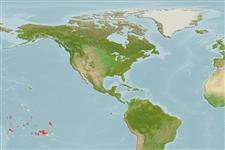Klassifizierung / Names
Namen | Synonyme | Catalog of Fishes(Gattung, Arten) | ITIS | CoL | WoRMS | Cloffa
>
Anguilliformes (Eels and morays) >
Ophichthidae (Snake eels) > Ophichthinae
Etymology: Yirrkala: Named for its type locality Yirrkala, Caledon Bay, Gulf of Carpentaria, Queensland, Australia.; moorei: Named for Gordon E. Moore..
More on author: McCosker.
Environment: milieu / climate zone / depth range / distribution range
Ökologie
seewasser demersal; tiefenbereich 25 - 454 m (Ref. 56883). Tropical
Western Central Pacific: Marquesas and American Samoa.
Size / Gewicht / Alter
Maturity: Lm ? range ? - ? cm
Max length : 43.4 cm TL Männchen/unbestimmt; (Ref. 56883)
Kurzbeschreibung
Morphologie | Morphometrie
Wirbelzahl: 162 - 173. Diagnosis: Color pale, overlain with a broad longitudinal brown stripe above the lateral midline. Head 6.3-6.9% of total length (TL); tail 48-52% of TL. Dorsal fin in advance of the gill openings. Eye above middle of upper jaw. Teeth conical, minute, uniserial on jaws and vomer. Total vertebrae 162-173 with mean vertebrae formula 4-77.5-167 (Ref. 56883).
Maximum length (434 mm) given was for an immature male.
Life cycle and mating behavior
Geschlechtsreife | Fortpflanzung | Ablaichen | Eier | Fecundity | Larven
McCosker, J.E., 2006. A new species of sand eel, Yirrkala moorei (Anguilliformes: Ophichthidae), from the South Pacific. Proc. Calif. Acad. Sci. 57(10):373-377. (Ref. 56883)
IUCN Rote Liste Status (Ref. 130435)
Bedrohung für Menschen
Harmless
Nutzung durch Menschen
Mehr Information
NamenSynonymeMetabolismusRäuberÖkotoxikologieFortpflanzungGeschlechtsreifeAblaichenSpawning aggregationFecundityEierEientwicklung
Alter/GrößeWachstumLänge-GewichtLänge-LängeLängenhäufigkeitenMorphometrieMorphologieLarvenLarven Pop.Dyn.RekrutierungDichteBRUVS
ReferenzenAquakulturAquakultur ProfilZuchtlinienGenetikElectrophoresesVererbbarkeitKrankheitenVerarbeitungNutrientsMass conversion
PartnerBilderStamps, Coins Misc.LauteCiguateraGeschwindigkeitSchwimmstilKiemenoberflächeOtolithsGehirngrößeSehfähigkeit
Tools
Zusatzinformationen
Download XML
Internet Quellen
Estimates based on models
Preferred temperature (Ref.
123201): 3.3 - 5.7, mean 4.5 °C (based on 21 cells).
Phylogenetic diversity index (Ref.
82804): PD
50 = 0.5000 [Uniqueness, from 0.5 = low to 2.0 = high].
Bayesian length-weight: a=0.00089 (0.00039 - 0.00204), b=3.00 (2.80 - 3.20), in cm total length, based on LWR estimates for this (Sub)family-body shape (Ref.
93245).
Trophic level (Ref.
69278): 3.7 ±0.6 se; based on size and trophs of closest relatives
Widerstandsfähigkeit (Ref.
120179): hoch, Verdopplung der Population dauert weniger als 15 Monate. (Preliminary K or Fecundity.).
Fishing Vulnerability (Ref.
59153): Low to moderate vulnerability (33 of 100).
